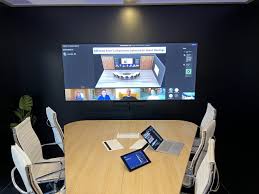Exploring Hybrid Meeting Room Solutions
In today’s fast-paced business world, the concept of hybrid meetings has become increasingly popular. As organizations embrace remote work and flexible schedules, the need for effective hybrid meeting room solutions has grown exponentially.
Hybrid meeting rooms are designed to accommodate both in-person and remote participants seamlessly. These solutions integrate advanced technology to ensure that all attendees, regardless of their physical location, can actively participate in meetings and discussions.
Key Features of Hybrid Meeting Room Solutions:
- Video Conferencing: High-definition cameras and microphones enable clear audio and video communication between in-person and remote participants.
- Interactive Displays: Touchscreen displays allow for real-time collaboration, annotation, and sharing of content during meetings.
- Wireless Connectivity: Seamless integration with various devices such as laptops, smartphones, and tablets for easy screen sharing and presentation.
- Data Security: Encryption protocols and secure network connections to protect sensitive information shared during meetings.
- Remote Control: Remote participants can control presentations, share screens, and interact with meeting room peripherals as if they were physically present.
The benefits of implementing hybrid meeting room solutions are numerous. They enhance collaboration among team members, improve communication efficiency, reduce travel costs, and increase overall productivity. Organizations that invest in these advanced technologies demonstrate a commitment to adaptability and innovation in today’s digital landscape.
If your organization is considering upgrading its meeting room capabilities to support hybrid meetings, exploring the latest solutions available in the market is essential. From hardware installations to software integrations, a well-designed hybrid meeting room can revolutionize the way your teams collaborate and communicate.
5 Essential Tips for Effective Hybrid Meeting Room Integration
- Ensure compatibility between virtual and in-person meeting tools.
- Invest in high-quality audio and video equipment for clear communication.
- Implement a reliable internet connection to avoid disruptions during meetings.
- Provide training for participants on how to use the hybrid meeting room technology effectively.
- Establish clear guidelines and protocols for hybrid meetings to ensure smooth collaboration.
Ensure compatibility between virtual and in-person meeting tools.
To optimize the effectiveness of hybrid meeting room solutions, it is crucial to ensure compatibility between virtual and in-person meeting tools. Seamless integration between different technologies such as video conferencing platforms, interactive displays, and collaboration software is essential for a smooth and productive meeting experience. By ensuring that all tools work harmoniously together, both remote and in-person participants can actively engage in discussions, share content effortlessly, and collaborate effectively, regardless of their physical location. Compatibility between virtual and in-person meeting tools is key to fostering a cohesive and inclusive meeting environment that maximizes engagement and productivity for all attendees.
Invest in high-quality audio and video equipment for clear communication.
Investing in high-quality audio and video equipment is crucial for ensuring clear communication in hybrid meeting room solutions. Clear audio and sharp video quality are essential for facilitating seamless interactions between in-person and remote participants. High-quality equipment not only enhances the overall meeting experience but also minimizes technical issues and distractions, allowing all attendees to actively engage in discussions and collaborate effectively. By prioritizing top-notch audio and video technology, organizations can create a professional and productive meeting environment that fosters meaningful communication and collaboration across physical boundaries.
Implement a reliable internet connection to avoid disruptions during meetings.
To ensure seamless communication and collaboration in hybrid meeting room setups, it is crucial to implement a reliable internet connection. A stable internet connection helps prevent disruptions such as audio or video lag, dropped calls, or screen freezing during meetings. By investing in a robust internet infrastructure, organizations can enhance the overall meeting experience for both in-person and remote participants, enabling productive and efficient communication across all locations.
Provide training for participants on how to use the hybrid meeting room technology effectively.
To ensure the successful implementation of hybrid meeting room solutions, it is crucial to provide training for participants on how to use the technology effectively. By offering comprehensive training sessions, organizations can empower their team members to navigate the features and functionalities of the hybrid meeting room setup with confidence. Training helps participants become proficient in utilizing video conferencing tools, interactive displays, wireless connectivity options, and remote control capabilities, ultimately enhancing collaboration and communication during hybrid meetings. Investing in training ensures that all participants can maximize the benefits of the technology and contribute meaningfully to virtual and in-person discussions.
Establish clear guidelines and protocols for hybrid meetings to ensure smooth collaboration.
Establishing clear guidelines and protocols for hybrid meetings is crucial to ensuring smooth collaboration among in-person and remote participants. By setting expectations regarding meeting etiquette, technology usage, speaking turns, and participation norms, teams can minimize confusion and maximize productivity during hybrid meetings. Clear guidelines help create a structured environment where all attendees feel included and engaged, leading to more effective communication and decision-making processes.

